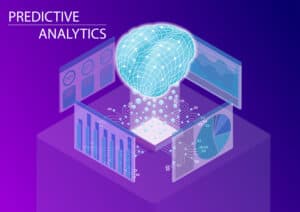
The combination of human interaction and AI’s predictive analytics will drive success through informed decision-making, better rick management, and improved customer experiences.
The rapid development of new technologies usually creates a constant cycle of cutting-edge tools appearing in the spotlight and overshadowing the last new thing. Yet since sophisticated artificial intelligence’s (AI) explosive arrival onto the tech scene, this powerhouse technology’s popularity shows no signs of diminishing. By 2027, the AI market is expected to reach a remarkable $407 billion, up from about $87 billion in 2022.
In today’s ultra-competitive business landscape, industries failing to embrace this burgeoning technology will lag behind those that do. A 2020 survey found that 77% of bankers think the future success of banks will hinge on their ability to use AI technology effectively.
Many banks are already taking advantage of AI, leveraging it for customer service improvement, fraud detection, and risk management. AI-powered chatbots and automated loan decisioning have become more common, allowing banks to provide personalized assistance to their customers on demand.
Fostering customer trust is more important than ever, with the banking industry in turmoil after SVB’s March collapse. The smartest institutions will balance the power of AI’s predictive analytics with traditional human interactions to enhance user experiences that drive loyalty and retention.
AI with a human touch
Even with the many digital channels available, some people will choose in-person banking. According to McKinsey research, 28% of banking customers prefer physical branches. Even with sophisticated AI, the banking landscape still needs humans to interpret the data insights produced by predictive analytics. That wealth of data is meaningless without a person to understand its significance.
Beyond analysis, some problems are too nuanced and complicated for AI to parse. In these instances, AI can answer customer FAQs and automate time-consuming, repetitive processes, freeing up live representatives’ time to tackle the most complex issues.
See also: Predictive Analytics, ML, AI – Do I Have to Choose?
AI on its own
Sometimes, however, customers do feel more comfortable with AI than humans. Financial troubles remain a very sensitive issue to discuss, with many people worried about their financial future and unsure of what steps to take. Shame and fear of judgment prevent people from seeking help to get their finances back on track. Interacting with a chatbot incapable of judgment offers one option for asking questions and receiving guidance. AI can quickly aggregate and synthesize complex datasets — credit reports, budgets, income, expenses, and more — and provide personalized financial advice and feedback in seconds.
Many younger people also prefer to interact solely with AI since they’re accustomed to interactions via text and conducting “back and forth” virtual conversations at their convenience. Those looking to change their financial habits need education, introduction of new habits, and a measure of accountability to sustain behavioral change. An AI-driven virtual assistant can provide that support and encouragement through the gamification of financial habit changes. When someone makes positive changes, AI provides “rewards” to further encourage the behavior. AI can also send out reminders when a customer must take specific actions to keep their financial journey on track.
See also: Future-Proofing Banking: 4 Steps Toward a Tech-Driven Customer Experience
Significance of predictive analytics
Predictive analytics uses data to identify patterns that could forecast potential outcomes. Benefits of this technology for banks include:
Informing decision-making. Predictive analytics analyzes historical data to find trends and patterns predicting customer behavior and preferences. These valuable insights can fuel innovation, enhancing product and service offerings. If the data suggests a bank’s customers want financial guidance, that information can catalyze the bank’s decision to develop empowering educational resources.
Improving customer experiences. Over 70% of consumers expect personalization, and 76% get frustrated when it fails. By analyzing customer data, such as transaction history and behavior patterns, banks can target specific customer segments with personalized offers and tailored marketing campaigns. Banks can also use geofencing to target customers with location-based deals and advertisements.
Nurturing customer relationships. Predictive analytics anticipates customer needs and provides proactive solutions. For example, suppose the forecast flags a customer with a higher likelihood of churning. To prevent churn, the bank could implement retention initiatives, such as offering discounts or special offers. Retention is key to driving success since businesses are up to 70% more likely to sell to existing customers than prospects.
Predictive analytics can help banking leaders develop strategies that enhance customer engagement and satisfaction. AI can analyze data to derive insights from historical patterns and predict trends in customer behaviors and evolving expectations for their banking experience, like seamless online banking, the ability to direct deposit checks from the banking app, and easy navigability.
Managing risk. Predictive analytics help optimize risk management strategies. By analyzing large volumes of transactional data and applying machine learning (ML) algorithms, banks can identify patterns and anomalies indicative of fraudulent activities and security threats, such as identity or data theft to steal from accounts, triggering alerts that enable banks to act immediately to prevent financial losses and protect customers.
Technological advancements have also led to newer, more sophisticated threats. A combination of human intelligence and intuition and AI and ML models can identify the intricacies of attack patterns numerical analysis alone won’t recognize. Data analyses can also evaluate consumers’ creditworthiness and predict risks of default or delinquency so banks can take appropriate measures to minimize potential losses.
Appeal of predictive analytics to financial service providers
The availability of robust analytics solutions positions retail banks as attractive partners for financial services providers. By sharing analytics-driven insights, banks empower their partners to:
- Make data-informed decisions.
- Enhance their offerings.
- Optimize operational efficiency.
- Reduce costs.
- Drive business growth.
- Gain a deeper understanding of customer needs/preferences to better serve them.
Strategic partnerships between retail banks and financial services providers benefit both parties, enabling them to use their strengths and enhance their value propositions in the market. Here’s one potential use case: if the data analysis shows that customers want a credit score solution, banks can use that information to partner with a financial service provider that has a tool granting customers instant access to their credit score.
What the future holds
As technology evolves, the combination of human interaction and AI’s predictive analytics will drive success by informing decision-making, managing risk, and improving customer experiences. Manual strategies simply cannot handle analyzing terabytes of data. Banks leveraging AI technology gain a competitive advantage and build stronger customer relationships.




























